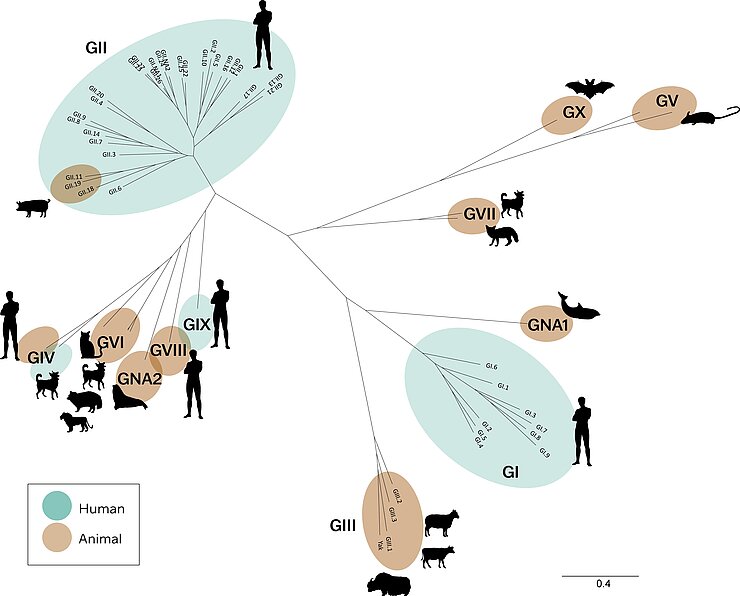Research

Norovirus are the most common viral cause of acute gastroenteritis, a severe inflammation of the intestine. More than 40 Norovirus genotypes have been described to date with new genotypes and variants regularly emerging. While we often think of noroviruses as human pathogens, they actually have a much broader host range including domestic animals like cats, dogs, and cows as well as wild animals such as rodents, bats, raccoon dogs and foxes. The close genetic similarity between some animal and human noroviruses combined with sporadic surveillance evidence raises the question if animals could be acting as hidden reservoirs, allowing noroviruses to evolve and potentially re-emerge in humans.
The aim of this project is to set up an ex vivo system to study the molecular interspecies transmission barriers for noroviruses in humans and animals and to understand norovirus susceptibility and host determinants in non-human animals. Shedding light on the interspecies transmission of viruses, including noroviruses, is important to understand virus emergence and circulation. The first step is identifying which animals likely act as norovirus reservoirs, allowing for a more focused surveillance study.
More information about my research:
Publications
1)Izquierdo-Lara RW, Villabruna N, Hesselink DA, Schapendonk CME, Ribó Pons S,Meier JIJ, Goodfellow I, Dalm V, Fraaij PLA, van Kampen J, Koopmans MPG, de GraafM. (2024) Patterns of the Within-Host Evolution of Human Norovirus in Immunocompromised Individuals and Implications for Treatment. eBioMedicine, 109.doi.org/10.1016/j.ebiom.2024.105391 (Link)
2)Villabruna N, Izquierdo-Lara RW, Schapendonk CME, de Bruin E, Chandler F, Thao TTN, Westerhuis BM, van Beek J, Kohns Vasconcelos M, Sigfrid L, Giaquinto C, Goossens H, Bielicki JA, Fraaij PLA, Koopmans MPG and de Graaf M. (2022) Profiling of humoral immune responses to norovirus in children across Europe. Scientific Reports, 12(1): p.14275. doi.org/10.1038/s41598-022-18383-6 (Link)
3)Van Kampen JJA, Dalm VASH, Fraaij PLA, Oude Munnink BB, Schapendonk CME, Izquierdo-Lara RW, Villabruna N, Ettayebi K, Estes MK, Koopmans MPG, de Graaf M. (2022) Clinical and in-vitro evidence favoring immunoglobulin treatment of a chronic norovirus infection in a patient with common variable immunodeficiency. The Journal of Infectious Diseases, 226(19): p.1781-1789. doi.org/10.1093/infdis/jiac085 (Link)
4)Villabruna N, Schapendonk CME, Aron GI, Koopmans MPG, de Graaf M. (2021) Human noroviruses attach to intestinal tissues of a broad range of animal species. Journal of Virology, 95(3). doi.org/10.1128/JVI.01492-20 (Link)
5)Villabruna N, Izquierdo Lara RW, Szarvas J, Koopmans MPG and de Graaf M. (2020) Phylogenetic investigation of norovirus transmission between humans and animals. Viruses, 12(11): p.1287. doi.org/10.3390/v12111287 Link
6)Villabruna N, Koopmans MPG, de Graaf M. (2019) Animals as reservoir for human norovirus. Viruses, 11(5): p.478. doi.org/10.3390/v11050478 (Link)
7)De Graaf M, Villabruna N, Koopmans MPG. (2017) Capturing norovirus transmission. Current Opinion in Virology, 22: p.64-70. doi.org/10.1016/j.coviro.2016.11.008 (Link)




